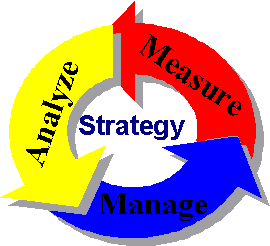Performance Management is the process of measuring and analyzing key performance indicators (KPI) in order to manage the internal business processes which drive those indicators for the purpose of improving efficiency and achieving both strategic and tactical objectives. This is an iterative process which yields progressive business process improvements.
CorVu's Performance Management solution enables organizations in any industry to measure, analyze and manage financial and operational performance at all levels to derive the following business benefits:
- Translate strategic and tactical corporate objectives into individual performance measures
- Offer every employee a blueprint for contributing to the overall corporate vision
- Link performance results with the processes which drive those results
- Align Strategy with tactical operations
- Leverage the value of all other IT applications
These benefits are delivered via the following key features:
No Programming
Using Windows Wizards, performance scorecards are easily designed without any tedious programming. Descriptive notes and commentary give users insight into the desired intent of each measure.Interactive Scorecard Analysis
Users simply click on a given KPI to employ CorVu’s powerful business intelligence features. This enables users to interactively analyze performance data. Thus, performance results are linked directly to the business processes which drive those results. This linkage enables users to better manage business process improvement.Automatic Scorecard Updates
Scorecards are automatically updated using CorVu’s Intelligent Scheduler. So performance data is as current needed.Simple Scorecard Maintenance
As business strategies are modified, CorVu allows you to easily add and/or delete measurement metrics using the same familiar Windows Wizards.Cascading Scorecards
Scorecards may be linked to convey hierarchical organizational structures and enable varied measurement metrics at each level.Powerful Database Connectivity
Performance scorecards utilize CorVu’s powerful database connectivity to access performance data. Data sources may include relational and/or multidimensional databases, flat files and even proprietary files.
The iterative nature of this entire process is illustrated below.
 |
After deciding on an organizational strategy, the iterative cycle of measuring, analyzing and managing begins. CorVu automates the processes of measuring and analyzing as follows:
Step 1: Measure
Performance Data Normalization
This process enables the integration of incompatible measurement types. For example, the marketing department of a retail store may include the following as KPIs:1) marketing cost as a percentage of sales
2) number of responses from each marketing campaign
3) total revenue from each marketing campaign
4) time duration of each marketing campaignEach of these KPIs represents a different type of measurement. The first will return a percentage value (56%), the second an integer value (104,753), the third a value in currency ($2,345,732), and the fourth a measurement of number of days, weeks or months (150 days). Rather than dealing with each measurement type, performance data normalization converts each to a value between 0 and 10. CorVu does this by allowing users to specify the best and worst values for each KPI. The best value becomes a score of 10, the worst a score of 0. Actual measurement results are then provided a score between 0 and 10 depending on where they fall between the best and worst possible values. Thus, incompatible KPIs are easily compared with one another.
This operation also makes performance results easy to understand and assimilate. In the example above, is it likely that the CFO of the retail store would know if marketing costs of 56% was high or low? Likewise, is the Director of Human Resources expected to know if 30 minutes is a good response time for customer service calls? Normalizing all scores on a scale of 0 to 10 enables all staff to easily identify good and poor performance.
Relative Weighting of KPIs
Relative weighting of KPIs is also necessary. In the case of the marketing department, the total revenue from each campaign might be more critical than the time duration. Thus, users must be able to establish the relative importance of each KPI. The above example might be weighted as follows:1) (35%) marketing cost as a percentage of sales
2) (15%) number of responses from each marketing campaign
3) (35%) total revenue from each marketing campaign
4) (15%) time duration of each marketing campaignEach of the above capabilities is delivered via standard Windows Wizards. So there is no programming involved. The flexibility enables users to design a measurement system which matches their organizational strategy. Thus, CorVu's Performance Management solutions help drive your organization in the direction of your strategy.
Step 2: Analyze
Interactive Scorecards
Many performance management systems produce only "static" scorecards. A "static" scorecard is one in which the performance results are not linked "online" with the measured performance data. Such systems make it difficult to link cause and effect relationships. Stated differently, such systems make it difficult to link performance results with the business processes which drive those results.In order to make this cause and effect linkage easily, users must be able to interactively analyze performance results. CorVu's integration of its Performance Management System with its Business Intelligence solutions enables such interactive analysis. This means that while viewing their scorecards users simply click on any of the color-coded KPIs to interact with the performance data. Upon so doing, users may drill into, slice-and-dice, graph and query the performance data making up this KPI. In short, they have at their fingertips the power of CorVu's Integrated Business Intelligence Suite.
Step 3: Manage
While CorVu will not be instrumental in the implementation of new business processes, without the ability to utilize its powerful measurement and analysis capabilities, users find it difficult to know exactly what to manage. Thus, before the process can be managed, it must first be measured and analyzed. Therefore, CorVu's value is in its ability to deliver the knowledge required to make the right management decisions.